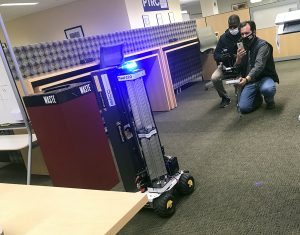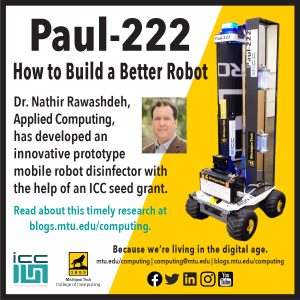By Karen S. Johnson, Communications Director, College of Computing
Assistant Professor Nathir Rawashdeh, Applied Computing, has developed a mobile robot disinfector with the help of a seed grant from Michigan Tech alumnus and donor Paul Williams ’61 EE. Read about this timely research below.

Some Background: (UV)-C Light
Airborne microbial diseases such as influenza, tuberculosis, and now the new corona virus, represent major public health challenges. Ultraviolet (UV)-C light, discovered more than a century ago, effectively inactivates these types of pathogens in minutes by damaging the virus’s DNA. It has been studied widely and is used in applications like water treatment and preventing the spread of pathogens in hospitals.
And UVC light is safe when used correctly. However, its widespread use in public settings is limited because it is harmful to human skin and eyes and it has been shown to cause cancer.
There are many UV-based surface and air disinfecting systems out there, and they typically use the germicidal UVC 254 nanometer light. And while it is easily obtained, low cost, and very effective, UVC 254 nanometer light is harmful to humans and can be used only when a space is vacant.
“Building a multidisciplinary robot like this, one that contains mechanical, electrical, and computational components, is an example of applied mechatronics at work.”
A Safer Alternative: Far-UVC Light
Recently, experiments have been performed on the shortwave length of 222 nanometer, also knows as Far-UVC light.
“Far-UVC 222 nm light, on the other hand, efficiently inactivates bacteria and it doesn’t hurt humans,” Rawashdeh explains. “But it’s expensive and difficult to acquire, although as the technology is used more, I expect it will become less costly.”
Researchers began focusing on Far UVC in the last decade, and it was recently shown to effectively kill viruses and pathogens. (Nature, 2020). The shorter 222 nm wavelength cannot penetrate the tear layer of the eye or the outer dead-cell layer of skin, so it cannot reach or damage living cells in the body. And because Far-UVC is safe for skin and eyes, the products can run constantly, continuously killing pathogens like viruses and bacteria without worry about human exposure.
“Far-UVC light has a been shown to be incapable of penetrating the outer dead-cell layer of human skin or the tear layer in the eye, so it’s not a human health hazard,” confirms Rawashdeh. “Continuous very low dose-rate Far-UVC light in indoor spaces is a promising and safe tool to reduce the spread of airborne-mediated microbial diseases.

Paul-222: An Opportunity for Innovation
Only a few manufacturers are currently producing Far-UVC products, and Rawashdeh believes the time is right to develop this disinfection technology further.
“Today’s robots are just carts, they drive into room to irradiate it, then leave the room,” says Rawashdeh,” They don’t have the intelligence for detecting humans or deciding what to disinfect. Several companies are now developing intelligent disinfection robots, but I am convinced that the 254 UVC will remain too dangerous, and that the application of the 222 nm wavelength is much more suitable”.
Rawashdeh has developed what he calls “Paul-222”, a tele-operated mobile robot disinfector with first-person-view and two wavelengths: a standard 254 nanometer UVC light side and a 222 nanometer Far-UVC side, as a prototype to compare the disinfection efficiency of the two technologies relative to power requirements, radiation intensity, and disinfection times.
“The next version of this prototype will be an autonomous and collaborative robot,” says Rawashdeh. “It will be aware of human presence and disinfect while the room is occupied. This doesn’t exist today.”

Designed and Built at Michigan Tech
The prototype was designed and built at Michigan Tech during the COVID-19 quarantine in summer 2020.
There was an emergency call for Institute of Computing and Cybersystems (ICC) seed grant proposals in May 2020 to address COVID-19, and Rawashdeh had only two weeks to apply. But in less than a month, he had won the funding—as did several colleagues in the College of Computing—received access to the funds, and started building and testing.
“This was a very generous gift from Paul Williams through the ICC,” Rawashdeh said.
Rawashdeh completed the disinfector as a solo project while the labs were closed for group work, with help from EET undergraduate Austin Kucharski, who helped build the remote-control components.
Thorough testing has confirmed the effectiveness of both sides of the unit. The UVC side kills the coronavirus in ten seconds at a distance of three feet, while the Far-UVC side needs three minutes. The disinfector can be recharged simply by plugging it into an electrical outlet.
Rawshdeh oversees the Mobile Robotics Lab, which pursues work in mobile robots, depth sensing, robot environment simulation, image analysis, thermal imaging, sensor fusion, electrical engineering and control. Visit the lab’s website at www.morolab.mtu.edu.
The Prototype
Paul-222 is a prototype, which means that it is composed of a mix of off-the-shelf parts and materials. For instance, a camping battery powers the lights and electronics, and the oscillating light bar in the front of the unit is an automotive accessory. A separate battery powers the motion of the unit, and the first-person-view is based on a wireless backup camera and screen system for RVs. One of the reflecting fixture backsides is a metallic automotive dash cover.
Safety was an important consideration in the design of the disinfector. A camera in the front of the unit provides first-person view for remote operation. Flashing lights alert those in the vicinity, and remote operation means it can be controlled from a distance only when it’s safe.

Searching for Collaborators
Rawashdeh is looking to develop this idea further and is searching for collaborators, such as those studying human-centered computing and intelligent algorithms. And he’s looking for public facilities interested in helping test the Paul-222 robot, including libraries, grocery stores, and health clinics.
“There will likely be a next pandemic, and such robots can be deployed at outbreak hot spots” Rawashdeh says. “Fighting pathogens will continue to be a priority.”
Rawashdeh plans to present his invention at a future technical conference. He also expects to demonstrate the protype at future campus events and technology exhibits.
Watch a video demonstration of the disinfecting robot.
The Institute of Computing and Cybersystems

Rawashdeh is a member of the Center for Data Sciences (DataS) research group of the Institute of Computing and Cybersystems (ICC) focuses on the research of data sciences education, algorithms, mathematics, and applications.
“The ICC is always encouraging and supporting us to write proposals and collaborate,” Rawashdeh says. “The results of this research are a great example of what the ICC can do in a short time. I’m grateful to Paul Williams, the ICC, and ICC director Tim Havens for their support.”